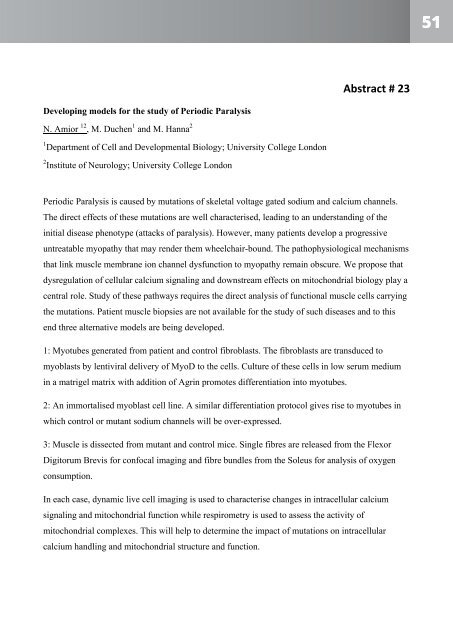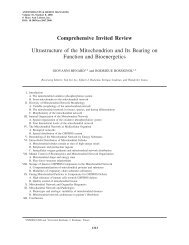MiPsummer Programme pdf - Mitochondrial Physiology Society
MiPsummer Programme pdf - Mitochondrial Physiology Society
MiPsummer Programme pdf - Mitochondrial Physiology Society
You also want an ePaper? Increase the reach of your titles
YUMPU automatically turns print PDFs into web optimized ePapers that Google loves.
51<br />
Abstract # 23<br />
Developing models for the study of Periodic Paralysis<br />
N. Amior 12 , M. Duchen 1 and M. Hanna 2<br />
1 Department of Cell and Developmental Biology; University College London<br />
2 Institute of Neurology; University College London<br />
Periodic Paralysis is caused by mutations of skeletal voltage gated sodium and calcium channels.<br />
The direct effects of these mutations are well characterised, leading to an understanding of the<br />
initial disease phenotype (attacks of paralysis). However, many patients develop a progressive<br />
untreatable myopathy that may render them wheelchair-bound. The pathophysiological mechanisms<br />
that link muscle membrane ion channel dysfunction to myopathy remain obscure. We propose that<br />
dysregulation of cellular calcium signaling and downstream effects on mitochondrial biology play a<br />
central role. Study of these pathways requires the direct analysis of functional muscle cells carrying<br />
the mutations. Patient muscle biopsies are not available for the study of such diseases and to this<br />
end three alternative models are being developed.<br />
1: Myotubes generated from patient and control fibroblasts. The fibroblasts are transduced to<br />
myoblasts by lentiviral delivery of MyoD to the cells. Culture of these cells in low serum medium<br />
in a matrigel matrix with addition of Agrin promotes differentiation into myotubes.<br />
2: An immortalised myoblast cell line. A similar differentiation protocol gives rise to myotubes in<br />
which control or mutant sodium channels will be over-expressed.<br />
3: Muscle is dissected from mutant and control mice. Single fibres are released from the Flexor<br />
Digitorum Brevis for confocal imaging and fibre bundles from the Soleus for analysis of oxygen<br />
consumption.<br />
In each case, dynamic live cell imaging is used to characterise changes in intracellular calcium<br />
signaling and mitochondrial function while respirometry is used to assess the activity of<br />
mitochondrial complexes. This will help to determine the impact of mutations on intracellular<br />
calcium handling and mitochondrial structure and function.



